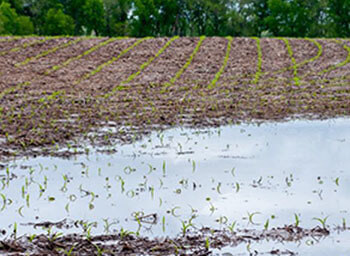Dealing with soil drainage issues
Dec 28, 2020

Almost every grower has at least one field with drainage issues. Although it may sometimes seem hopeless, there are some ways to improve a field’s drainage. Listed below are three suggestions.
When trying to fix drainage issues, think first about drainage tile. Could drainage tile be installed? The field’s soil structure is very important for drainage with or without drain tile. Soil structure creates pore space in soil, and these pore spaces allow water to infiltrate and then percolate through channels created by soil organisms and from decaying roots. Soil tillage breaks apart soil structure and reduces pore space causing slower infiltration rates and increased amounts of erosion. Overcoming the negative effects of tillage such as reduced soil structure and increased soil erosion are the main reasons why no-till has become so popular over the last 20 years.
Cover crops are excellent at using up excess water and creating channels in the soil which helps speed up water movement through soil profiles. Even with the best management practices, some soils still tend to be a little more wet natured due to topography and/or a high-water table due to high amounts of rainfall. Under these circumstances, hybrids should be selected that can tolerate wetter soils, and fields may have to be planted at a later date when the water table has moved down.
Delaying planting until soil is dry enough to plant is important. Soils that are planted when wet will have increased compaction problems with plants suffering from side wall compaction causing roots to be restricted to the seed trench and not be able to cover as much soil area. Roots that are limited on soil area will stress easier due to having less access to water and nutrients.
If a field does not show a positive return on investment after looking at alternatives to reduce water issues, it may be time to look into other farming options for this field in the future. In some situations, even with field drainage improvements, the field in question may just be in a low place with limited ways to control excess water. The old adage “live where you farm, don’t farm where you live” carries a lot of merit.
For more information about field drainage, contact your local Co-op or Greenpoint agronomist.
When trying to fix drainage issues, think first about drainage tile. Could drainage tile be installed? The field’s soil structure is very important for drainage with or without drain tile. Soil structure creates pore space in soil, and these pore spaces allow water to infiltrate and then percolate through channels created by soil organisms and from decaying roots. Soil tillage breaks apart soil structure and reduces pore space causing slower infiltration rates and increased amounts of erosion. Overcoming the negative effects of tillage such as reduced soil structure and increased soil erosion are the main reasons why no-till has become so popular over the last 20 years.
Cover crops are excellent at using up excess water and creating channels in the soil which helps speed up water movement through soil profiles. Even with the best management practices, some soils still tend to be a little more wet natured due to topography and/or a high-water table due to high amounts of rainfall. Under these circumstances, hybrids should be selected that can tolerate wetter soils, and fields may have to be planted at a later date when the water table has moved down.
Delaying planting until soil is dry enough to plant is important. Soils that are planted when wet will have increased compaction problems with plants suffering from side wall compaction causing roots to be restricted to the seed trench and not be able to cover as much soil area. Roots that are limited on soil area will stress easier due to having less access to water and nutrients.
If a field does not show a positive return on investment after looking at alternatives to reduce water issues, it may be time to look into other farming options for this field in the future. In some situations, even with field drainage improvements, the field in question may just be in a low place with limited ways to control excess water. The old adage “live where you farm, don’t farm where you live” carries a lot of merit.
For more information about field drainage, contact your local Co-op or Greenpoint agronomist.